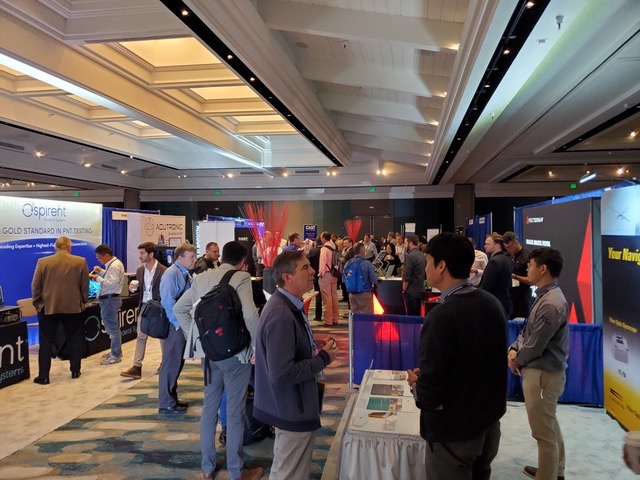During the Position Location and Navigation Symposium (PLANS) in Monterey, Calif., attendees not only had the chance to take in a variety of technical sessions, they also had the opportunity to learn from some of the manufacturers helping to advance the PNT industry.
About 17 exhibitors made up the show floor and educated attendees about new and upcoming solutions as well as proven technologies. The conference was co-sponsored by IEEE’s Aerospace and Electronics Systems Society (AESS) and the Institute of Navigation (ION).
Most IEEE/ION PLANS attendees wanted to talk about the hot industry topics, including spoofing, interference, simulation and LEO, Spirent Federal Systems Senior Systems Engineer Phillip Bonilla said. Many were interested in the company’s new all-in-one spoofing solution for the GS9000 GNSS Simulator to generate spoofing scenarios in SimGEN as well as its GNSS testing tools for LEO.
Spirent is partnering with LEO PNT providers like Xona Space Systems, he said, “to bring simulation and their signals into our portfolio.” Xona’s PULSAR service is set to become the first LEO PNT constellation to provide an advanced, independent service while augmenting existing GNSS.
Syntony is also putting a focus on LEO, and Gary Hannum, VP Sales USA, spent time talking with attendees about the company’s recently announced partnership with Xona. Through the partnership, Xona Space Systems’ LEO PNT constellation will be integrated into the company’s GNSS simulators and receiver solutions.
Safran Sensing Technologies featured its tactical grade MEMS gyros and IMUs, as well as its simulation devices for testing receivers in a lab environment. Through a new partnership, Orolia, a Safran Electronics & Defense company, also has partnered with Xona to develop support for LEO constellation and navigation signals in its Skydel-powered simulation and testing products.
Exail, the brand that combines iXblue and ECA Group, mainly focused on motion simulation during the conference, Motion Simulators Product Line Manager Nicolas Bernard said. The company’s two-axis positioning and rate tables, for example, draw a lot of interest from universities and can be expanded with the single axis options to create three-axis solutions for larger projects. Ideal Aerosmith also offers motion simulation solutions and an Inertial Test Lab, with the 1281 Single Axis Position and Rate Table System and the 1542C-12-TL Series Two Axis Positioning and Rate Table System among the offerings featured at the show.
CAST Navigation also showcased GNSS/INS simulation systems, including the CAST-INS, CAST-GPS, CAST-GNSS and CAST-Jammer.
Thales AVS France SAS highlighted its TopAxyz product line, including a recently launched high navigation grade MEMs accelerometer. The solution features added range for applications that require high accuracy in complex environments, including missile launches and civil aviation.
Inertial Labs showcased its tactical grade, ITAR-free IMUs, which contain three advanced MEMS gyroscopes and three high-performance accelerometers, and its Remote Sensing Payload Instrument (RESEPI). The RESEPI XT-32, launched last year, is a combined dual antenna GNSS-aided inertial navigation system, datalogger, LiDAR, camera and communications system that allows for real-time and post-processed generation of point cloud solutions. The next version is expected to be released in 2014, as is a new visual navigation solution that can be leveraged when GPS is denied, Product Manager William Dillingham said.
First time PLANs exhibitor TDK focused on three new products released earlier this year: the AXO301, a low-noise and high-resolution ±1 g accelerometer for high precision acceleration/deceleration measurements in railway applications and inclination control in industrial applications; AXO305, a ±5 g accelerometer designed for navigation, positioning and motion control of land and marine manned and unmanned systems; and the Tronics GYPRO 4300, a high stability and vibration-tolerant digital MEMS gyroscope for dynamic applications.
All three products have a digital output and come in a single package, Product Marketing Manager Pierre Gazull said.
“If you know how to integrate one, you know how to integrate the other,” he said. “This is unique in this industry, to have one package for both accelerometers and gyros.”
Silicon Sensing Sales Manager Greg Wilkinson talked with attendees about the company’s latest high-performance non-ITAR MEMS IMU, the DMU41, an upgrade of the DMU30. It’s 30% smaller, lighter weight, lower power and offers more capability than its predecessor. It is designed to aviation standards, so it can be certified for high-end aviation. It will open markets where size, weight and power are critical, such as unmanned vehicle navigation. Variant A will be available in a few weeks for testing and Variant B, which will have all the capabilities incorporated, will be out later this year.
SDI showcased various low-noise, high-performance industrial and navigation grade MEMS-based accelerometers, with MEMS accelerometers the company’s sole focus. While the technology is different from the traditional quartz-based versions, with less noise and more stability over time and temperature ranges, the solutions have the same shape so it’s easy to drop them in as a replacement or to try them out, Test and Support Engineer Pete Hulbert said.
Gladiator Technologies, Acutronic, VectorNav Technologies, FIBERPRO and InertialWave were among the other exhibitors showcasing advanced solutions, including motion simulators, IMUs and GNSS/INSS systems, in the exhibit hall.
Technical sessions continued throughout Thursday, covering various hot button topics such as jamming, spoofing, aerial vehicle navigation, integrated inertial navigation systems, vision-based navigation and signals of opportunity.






